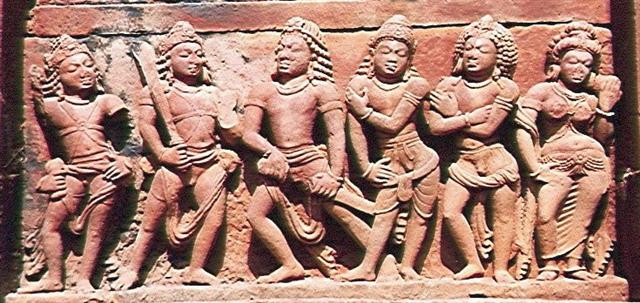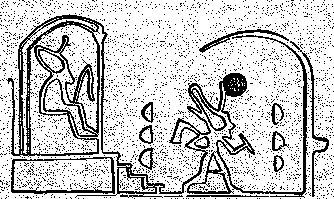10. Procyon means 'before the Dog' because it comes before the Dog-star (Sirius), and possibly this 'dog' is Dharma, the giver of law and order: ... One by one the pilgrims sank exhausted and expired, first Draupadi, then the twins, then Arjuna, then Bhima; but Yudhishtira, who never even looked back at his fallen comrades, still pressed on and, followed by the faithful dog who turns out to be Dharma (the Law), in disguise, entered Heaven in his mortal body, not having tasted death ... From left to right: Bhima, Arjuna, Yudhishtira, Nakula and Sahadeva (the twins), and Draupadi. But the faithful dog is not visualized:
We ought to include in our star pillar map also Sirius (Te Pou, Reitanga):
06h 46m is the rectascension of Sirus today. 6 * 60 + 46 = 406 minutes is 406 / 1440 = 28.194 % of the cycle. Arcturus is at 59.236 % * 365 = day 216, and the distance from Sirius to Arcturus in days is (0.59236 - 028194) * 365 = 113 days:
In my table Procyon comes after Sirius, not before. A higher rectascension value means an earlier appearance in the sky. Therefore time in a way moves from right to left in my tables, as the horizon in the east gradually produces star after star with lower and lower rectascension. Arcturus is rising earlier than Procyon and Procyon earlier than Sirius. The sky roof is seen moving from left to right north of the equator, but from right to left south of the equator (in both cases given that the face of the observer is turned towards the equator). However, in the order of time there is no left or right, and the sequence of sign stars remains the same. In ancient Egypt Sirius was connected with the rise of the Nile and responsible for its 'deluge' - in other words 'winter'. The name Reitanga suggests a similar idea on Easter Island, because rei-taga presumably means 'adornment caught in a sack' (cfr at Parehe and how at solstice the Sun bird is imagined to be caught in a bird-snare, mutu). The proper place of Sirius should be winter solstice:
There are 7 planets in the week, but the last of them is like the 29th night in the month (or the 365th day in the year) a dark one, the old fire must be quenched before a new fire will be released. The dog of Yudishtira (Sun) has the position of ko-ti (Saturn), trailing faithfully at the end of the company. He represents 'the dark chamber' and therefore cannot be pictured together with the Pandavas. I believe he was the wolf-god Upwaut of ancient Egypt, cfr at A Common Sign Vocabulary: ... The king, wearing now a short, stiff archaic mantle, walks in a grave and stately manner to the sanctuary of the wolf-god Upwaut, the 'Opener of the Way', where he anoints the sacred standard and, preceded by this, marches to the palace chapel, into which he disappears. A period of time elapses during which the pharaoh is no longer manifest ...
Probably Old Pharaoh is at left, and he is drawn as if floating in midair, with 4 + 1 steps leading up to him. And there certainly are more signs to be deciphered in this crucial picture. |
|||||||||||||||||||||||||||||||||||||||||||||||||||||||||||||||||||||||||||||||||||||||||||||||

